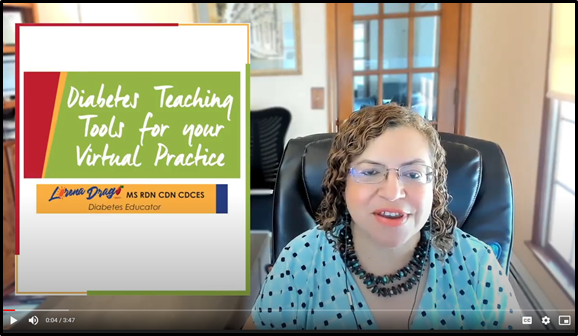
As telehealth continues to be a key aspect of healthcare, we reached out to our friend and fellow diabetes care and education specialist Lorena Drago MS, RDN, CDN, CDCES, owner of Hispanic Foodways LLC, to share her experience and solution-focused approach to engaging in successful telehealth visits.
Here is what Lorena shared with us….
Many health professionals have now adopted telehealth visits as part of diabetes care and education. I must admit that it has been a bumpy ride for health care providers and patients. Many of us have experienced technical issues. We are familiar with the “Can you hear me now?” plight as we connect to audio or have fallen victim to nostril intimacy when the patient moves the camera too close to the face. Let’s not mention those patients who believe pants are optional.
Overall, there are many advantages to telehealth, such as convenience, saving time, and saving money on travel. Despite working out some kinks, there are still some challenges, such as lack of internet, poor connectivity, and low digital health literacy.
After a year and a half of telehealth visits, I would like to share my solution-focused practice approach to optimizing virtual visits.
BEFORE THE VISIT: PREPARATION IS KEY
FOR THE PATIENT
Create a checklist and review with patient prior to the appointment.
- Does the patient have access to a computer, laptop, tablet, or phone?
- Does the patient have internet access?
- Have they downloaded the application they will use for the telehealth appointment? Do they need help? Do they know how to use it?
- Do they have a quiet designated space for the telehealth appointment?
- Has the patient completed labs, if required?
- Does the patient have his/her anthropometric measurements?
- Does the patient have his/her blood glucose results available?
- Is the patient able to upload his/her results into the hospital/clinic portal?
- Is the patient’s meter, CGM, smart insulin pens, and pump connected to a platform where the health care team can access the information?
- Have they completed the required patient forms prior to the appointment?
- Do they have insurance information?
- If it is a nutrition appointment, do they have foods and labels they would like to discuss?
A patient navigator or administrative staff can compile this information and help prepare the patient for the visit. For patients who experience some of the aforementioned challenges, a telephone visit may be preferable.
FOR THE DIABETES CARE AND EDUCATION SPECIALIST
Prepare the agenda for the visit.
What does the patient want to know? I ask the patient:
- What are 1-2 questions you would like answered before the end of this appointment?
- What would you like to learn today?
- What is going well with your diabetes management?
Build on what the patient already knows.
If you can share the screen, show the patient a list of foods. Ask, “which of these foods raise your blood glucose the most? If you are not sure, just tell me you are not sure.” After the individual selects the foods, I know what the knowledge gaps are, and I shift the education to bridging the gaps in knowledge. For example, I provide a handout with pictures of whole wheat bread, skim milk, whole milk, fish, carrots, nuts. If the patient says that whole milk raises blood sugar and skim milk does not, then I focus on discussing the difference between carbohydrates and fat.
Focus on the wins.
When you discuss glucose management, it is common to focus on out-of-range results. After all, it is paramount to identify and manage hypoglycemic events. However, there is an inherent fear that the healthcare provider will admonish the patient for poor results. To avoid this, I ask:
What do you think happened?
This question invites exploration and reflection. Allow the patient to pause and reflect. Usually, patients will say, “I forgot to eat, or I did not eat enough carbohydrates.” Ask,
What have you done in the past that has worked for you to remind you to do something?
This question will allow the patient to recall past effective strategies and positive outcomes. If the patient doesn’t come up with any answers, then offer suggestions that have worked for other patients.
Make sure to use teach-back. Ask:
Can you tell me or show me in your own words. Can you summarize the key points of today’s visit?
Goal setting
Establishing goals is often tricky for some patients. I usually create a list of goals and ask the patient to select an easy win. This way, it is easy to achieve, and the patient will be more likely to move forward. For those patients who are goal driven, formulate more complex goals and adapt to the patient.
AFTER THE VISIT: DATA REVIEW IS REIMBURSABLE
CPT Code & Service Provided
- 95249: Patient equipment, CGM placement, hook-up, calibration, training, sensor removal, and printout recording.
- Service performed by: MD, NP, PA, RN, PharmD, RDN, CDCES
- Reimbursement: Medicare: ~$55, Commercial ~$127
95251: CGM data interpretation
- Service performed by: MD, NP, PA
- Reimbursement: Medicare ~$40, Commercial: ~$100
99457, 99091: Remote patient monitoring; collection and interpretation of physiologic data
- Service performed by: MD or other qualified health professional
- Reimbursement: Medicare: ~$50-$60
Lorena created the Diabetes Teaching Tools for your Virtual Practice to help diabetes educators:
- Reduce consultation time
- In less than 3 minutes, identify what the client doesn’t know so you can focus on what the client needs to know.
- Engage the client in the learning process using “real-life examples.”
The diabetes teaching tool kit includes:
- 13 topics presented in a simplified-visually rich style
- 8 interactive activities with real-life examples to help patients use newly acquired information
- Tried and true carbohydrate knowledge assessment tool so you know what your patients know and don’t know about foods with carbohydrate
- Download and share with your patients: https://rd2rd.com/downloads/diabetes-teaching-tools-for-your-virtual-practice/
We thank Lorena for the multitude of solution-focused practice pearls she shared with us and our readers in this week’s blog!
Stop back by in 2 weeks to see what we write about as we continue to share about a variety of other technologies that impact and influence diabetes care and education!
We welcome anyone interested in our approach to Subscribe to our blog and we’ll email you when a new post is published!
If you are a health care professional and interested in learning more about our solution-focused practice and approach, when you subscribe to our blog, we’ll send you in return a FREE resource of 10 Solution-Focused Questions to start a solution-focused discussion with your clients.
Deb is employed by Dexcom, but her words and opinions in this blog are her own.
Tami is employed by the University of Kentucky HealthCare Barnstable Brown DIabetes Center, but her words and opinions in this blog are her own.




